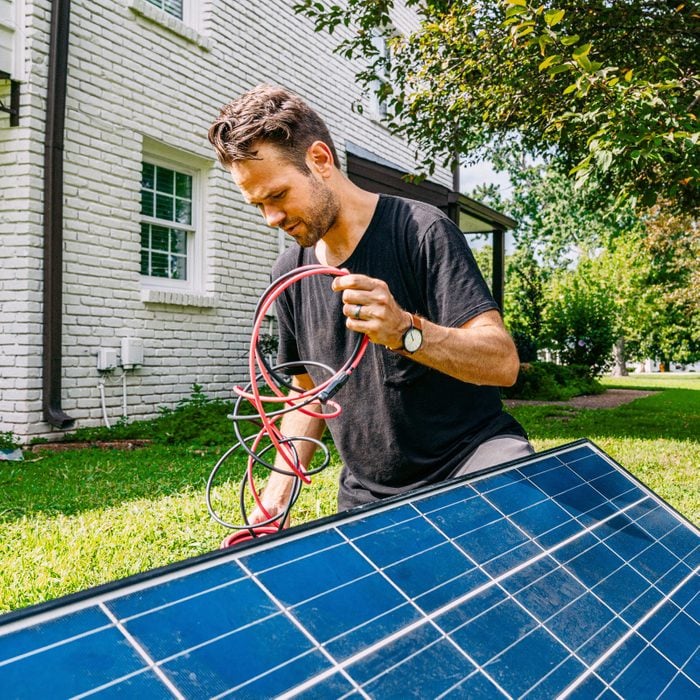Are DIY Solar Panels Worth It?
Updated: Mar. 22, 2024

Setting up a whole-house solar panel array may sound DIYable, but a pro explains why you'll get more out of your system if you trust the experts.
If you’re a diehard DIYer, you might think that assembling individual solar cells to make a solar panel is a fairly easy project that will save money. Unfortunately, that’s not quite the case. It’s a multi-step process that involves sensitive wiring. To purchase all the materials you need for the project, including the solar cells, backer board, bus bars and a protective covering, you’ll probably have to pay more than you would if you simply bought a panel.
But if you want to DIY the installation of a solar panel system…well, that’s a different story. I had been contemplating doing just that on my own property, but Jeremy Pearl, Residential Sales Manager for Sandbar Solar, a local solar installation company, set me straight.
“After 16 years in the solar industry, I’ve seen a bunch of DIY systems that were installed poorly, not up to code and with suspect and risky electrical work that put not only the homeowner’s family and property in jeopardy but the entire neighborhood and community due to increased fire risk,” says Pearl.
The part about fire risk caught my attention. There have been three major wildfires in my area since we moved here. A solar panel array may look passive and innocent, but it’s generating enough electricity to power a home, and all it takes is one crossed wire to spark another fire.
On This Page
What Are DIY Solar Panels?
“DIY solar panels” can refer to a panel someone builds themselves from individual solar cells. But practically speaking, these DIY panels are usually small and suitable only for lab experiments or to charge electronic equipment. If you’re a homeowner contemplating how to build your own solar panel, this probably isn’t what you’re thinking about. You’re probably more interested in pre-fabricated solar panels that you install yourself.
You can purchase solar panel kits online that come with everything you need to charge electronics and power small appliances. Usually intended for campers and RVers, these generate low-voltage (12, 24 or 48 volts) DC current that you can use directly with compatible equipment or pass through an inverter to run equipment that uses 120V AC power. The panels are prewired and come with their own mounts, so it’s fairly easy to deploy them and plug them in.
Whole-house solar panel arrays usually aren’t DIYable.
“While it’s debatable whether or not a homeowner is required to use a licensed electrician to install solar in CA, it is highly recommended,” says Pearl. “A DIY installer has the option to ‘self-install’ the modules, but the electrical work should be completed by a licensed electrical specialist.”
DIY Solar Panel Pros and Cons
Pros
- You can save money. When it comes to installing a permanent solar array capable of powering an entire house, it’s clear that you should hire out the electrical work to a licensed pro, but that still leaves tasks you can DIY. They include digging trenches for wires and installing panel mounts and batteries.
- Plug-and-play solar systems are elegant. Smaller solar energy systems that can power individual appliances are definitely DIYable. Companies like Bluetti, Delta and Jackery make it easy to set up panels, use them to charge a solar generator with a built-in inverter and plug your appliances right into the generator.
Cons
- You may have problems in the future. Pearl cautions that people who self-install, “…often miss administrative steps related to permitting and utility interconnections. That makes it especially difficult for a licensed contractor to expand the system later (i.e. adding batteries, more solar panels, EV charger, etc.).”
- Plug-and-play systems can be costly. Solar generator systems like the Delta Ecoflow, which can serve as a whole-house backup generator, cost almost $4,000 complete with one 400W solar panel. You’ll need more panels if you want faster charging. Even a small-capacity generator like the Bluetti EB70S costs more than $1,000, complete with one 200W panel. That’s a lot to pay for powering one or two small appliances.
Conclusion: Are DIY Solar Panels Worth It?
Solar research and development is very much an ongoing process, and innovations are always being introduced. Solar generators from companies like Bluetti, Jackery, GoalZero and Dabbson come complete with panels and are easy to set up anywhere that has enough sun. They aren’t yet viable standalone power sources for off-grid properties, but they can provide whole-house backup power for outages, and they generate enough energy to back-feed the grid and lower your electricity bill. Overall, they are solid investments.
If you’re planning a permanent solar installation, you can potentially save thousands by doing non-electrical work, such as placing panel supports and digging trenches yourself. Just don’t plan on doing the electrical hookups. Among the many reasons this is a bad idea, Pearl cautions that it’s difficult to find anyone to service a DIY solar installation if it doesn’t operate as expected.
Even if you do find someone to fix your DIY system, the expense is likely to be considerable, losing all the money you saved by doing the work yourself.
